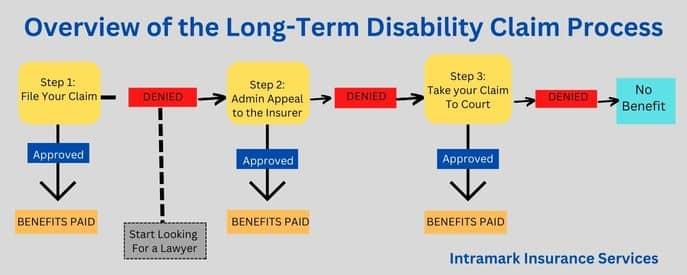Navigating the claims process for disability insurance can often feel like an overwhelming endeavor, especially during a time when clarity and support are most needed. Whether you are dealing with a temporary setback or a long-term disability, understanding how to effectively manage your insurance claim is crucial for securing the financial assistance you deserve. This article serves as a comprehensive guide to demystify the complexities of the disability insurance claims process. By breaking down each step with precision and offering expert insights, we aim to equip you with the knowledge and confidence necessary to navigate this critical aspect of your financial well-being. Whether you are initiating a new claim or managing an ongoing one, this guide will provide you with the authoritative advice needed to ensure a smooth and successful claims experience.
Understanding Key Terminologies and Definitions in Disability Insurance Claims
To navigate the complexities of disability insurance claims, it’s crucial to familiarize yourself with key terminologies that often surface during the process. Understanding these terms can greatly enhance your ability to manage your claim effectively. Here are some essential definitions to keep in mind:
- Elimination Period: The waiting period between the onset of a disability and when you begin to receive benefits. This period can vary, so review your policy to understand its specific duration.
- Own Occupation vs. Any Occupation: Policies may define disability differently based on your ability to perform your specific job (own occupation) or any job (any occupation) for which you are reasonably suited by education, training, or experience.
- Residual Disability: Refers to a condition where you can still work but at a reduced capacity. Understanding this term is crucial as some policies provide benefits for partial disabilities.
- Benefit Period: The length of time you will receive disability benefits. This period could range from a few years to until retirement age, depending on your policy.
Being well-versed in these terms not only prepares you for the discussions with your insurer but also empowers you to make informed decisions throughout the claims process. Make sure to consult your policy documents or a legal advisor for a more comprehensive understanding tailored to your specific situation.

Step-by-Step Guide to Filing a Disability Insurance Claim
Filing a disability insurance claim can seem daunting, but breaking it down into manageable steps can simplify the process. Begin by gathering all necessary documentation. This includes your policy details, medical records, and any communication from your healthcare providers. Ensure all documents are current and accurately reflect your condition. Once you’ve organized your paperwork, contact your insurance provider to initiate the claim. Ask for a claims packet if they haven’t already provided one, as this will contain essential forms and instructions.
Next, fill out the claim forms meticulously. Pay close attention to the details required, such as your personal information, the nature of your disability, and how it impacts your ability to work. Double-check for completeness and accuracy before submission. It’s also wise to keep a copy of everything you submit for your records. After submission, follow up with your insurer to confirm receipt and inquire about the expected timeline for a decision. During this period, be prepared to provide any additional information they might request. Keeping a proactive and organized approach will help ensure a smoother claims process.

Common Pitfalls and How to Avoid Them in the Claims Process
In navigating the labyrinth of disability insurance claims, certain missteps are all too common, yet entirely avoidable with the right foresight. Incomplete documentation often leads to delays or outright denials. Ensure every piece of required paperwork, from medical records to employment history, is meticulously compiled and submitted. Additionally, misunderstanding policy terms can create unnecessary obstacles. Take the time to thoroughly review your policy details and, if needed, consult with a professional to clarify any confusing language.
Another frequent issue is missing deadlines. Insurance companies adhere to strict timelines, and missing a deadline can jeopardize your claim. Keep a detailed calendar of all due dates and set reminders to stay on track. Moreover, insufficient communication with your insurance provider can lead to misunderstandings. Maintain regular contact, providing updates and promptly responding to any requests for additional information. By avoiding these pitfalls, you enhance your chances of a smooth and successful claims process.

Maximizing Your Benefits: Expert Tips for a Successful Claim Outcome
Securing a favorable outcome for your disability insurance claim involves more than just submitting paperwork. Thorough preparation and strategic actions can significantly enhance your chances of success. Here are some expert tips to help you navigate this complex process:
- Gather Comprehensive Documentation: Ensure that all your medical records, doctor’s reports, and any relevant employment documents are complete and up-to-date. Detailed evidence is crucial in demonstrating the validity of your claim.
- Understand Your Policy: Familiarize yourself with the specific terms and conditions of your disability insurance policy. This includes knowing the definitions of disability, the waiting period, and the duration of benefits. Awareness of these details can help you align your claim with the policy’s requirements.
- Maintain Consistent Communication: Regularly update your insurer on any changes in your condition and promptly respond to their requests for information. Clear and timely communication can prevent unnecessary delays and misunderstandings.
- Seek Professional Advice: Consider consulting with a disability insurance attorney or a claims specialist. Their expertise can provide valuable insights and guidance, ensuring that your claim is both compelling and compliant with all necessary protocols.

